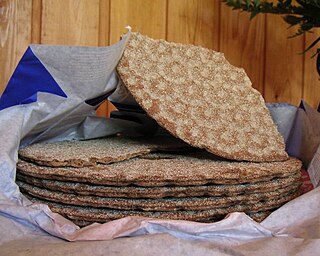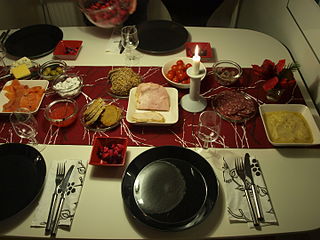| Type | Porridge |
|---|---|
| Place of origin | Finland |
| Main ingredients | Rye sourdough starter, potatoes, peas |
Hapanvelli (Finnish lit. 'sour gruel') is a traditional South-Eastern Finnish dish that resembles pea soup but has a more sour flavour. It takes roughly an hour to prepare hapanvelli, which is made from a rye sourdough starter, potatoes and peas. [1] It is traditionally served with a pat of butter and cold milk.
Hapanvelli is a traditional dish of the Virolahti municipality which has the annual summertime Virolahti Week (Virolahti-viikko) during which hapanvelli is sold. There is also a contest during Virolahti Week in which the best cook gets the title of Miss Hapanvelli (Hapanvellimissi). [2]

Swedish cuisine is the traditional food of Sweden. Due to Sweden's large north-to-south expanse, there are regional differences between the cuisine of North and South Sweden.

Finnish cuisine is notable for generally combining traditional country fare and haute cuisine with contemporary continental-style cooking. Fish and meat play a prominent role in traditional Finnish dishes in some parts of the country, while the dishes elsewhere have traditionally included various vegetables and mushrooms. Evacuees from Karelia contributed to foods in other parts of Finland in the aftermath of the Continuation War.

Polish cuisine is a style of food preparation originating in and widely popular in Poland. Due to Poland's history, Polish cuisine has evolved over the centuries to be very eclectic, and shares many similarities with other national cuisines. Polish cooking in other cultures is often referred to as à la polonaise.

Crispbread is a flat and dry type of bread, containing mostly rye flour. Crispbreads are lightweight and keep fresh for a very long time due to their lack of water. Crispbread is a staple food and was for a long time considered a poor man's diet.

Joulupöytä is the traditional assortment of foods served at Christmas in Finland. It contains many different dishes, most of them typical for the season.

Russian cuisine is a collection of the different dishes and cooking traditions of the Russian people as well as a list of culinary products popular in Russia, with most names being known since pre-Soviet times, coming from all kinds of social circles.

Lithuanian cuisine features products suited to the cool and moist northern climate of Lithuania: barley, potatoes, rye, beets, greens, berries, and mushrooms are locally grown, and dairy products are one of its specialties. Various ways of pickling were used to preserve food for winter. Soups are extremely popular, and are widely regarded as the key to good health. Since it shares its climate and agricultural practices with Northern Europe, Lithuanian cuisine has much in common with its Baltic neighbors and, in general, northern countries.

Ukrainian cuisine is the collection of the various cooking traditions of the people of Ukraine, one of the largest and most populous European countries. It is heavily influenced by the rich dark soil (chornozem) from which its ingredients come, and often involves many components. Traditional Ukrainian dishes often experience a complex heating process – "at first they are fried or boiled, and then stewed or baked. This is the most distinctive feature of Ukrainian cuisine".

Peasant foods are dishes eaten by peasants, made from accessible and inexpensive ingredients.
Latvian cuisine typically consists of agricultural products, with meat featuring in most main meal dishes. Fish is commonly consumed due to Latvia's location on the eastern shore of the Baltic Sea.

Belarusian cuisine refers to the culinary traditions native to Belarus. It shares many similarities with cuisines of other Eastern, Central and Northeastern European countries, based predominantly on meat and various vegetables typical for the region.

Slovenian cuisine is influenced by the diversity of Slovenia's landscape, climate, history and neighbouring cultures. In 2016, the leading Slovenian ethnologists divided the country into 24 gastronomic regions. The first Slovene-language cookbook was published by Valentin Vodnik in 1798.
In West Slavic countries, as well as in Russia, Belarus and in Ukraine, fermented cereals, such as rye, wheat, or oatmeal, are used to make soups. In Poland and parts of Belarus, rye is traditional for making żurek; a variant made with wheat flour instead of rye is known in Poland as barszcz biały. Fermented oatmeal is a common ingredient in Belarus and in some regions of Poland. Fermented wheat or sourdough soups are also found in other western Slavic cuisines, in particular in the Slovak (kyslovka), Silesian (Sauermehlsuppe) and Czech (kyselo) cuisines.
Traditional Estonian cuisine has substantially been based on meat and potatoes, and on fish in coastal and lakeside areas, but now bears influence from many other cuisines, including a variety of international foods and dishes, with a number of contributions from the traditions of nearby countries. Scandinavian, German, Russian, Latvian, Lithuanian and other influences have played their part. The most typical foods in Estonia have been rye bread, pork, potatoes and dairy products. Estonian eating habits have historically been closely linked to the seasons. In terms of staples, Estonia belongs firmly to the beer, vodka, rye bread and pork "belt" of Europe.

Soup is a primarily liquid food, generally served warm or hot, that is made by combining ingredients of meat or vegetables with stock, milk, or water. Hot soups are additionally characterized by boiling solid ingredients in liquids in a pot until the flavors are extracted, forming a broth. Soups are similar to stews, and in some cases there may not be a clear distinction between the two; however, soups generally have more liquid (broth) than stews.

Pea soup or split pea soup is soup made typically from dried peas, such as the split pea. It is, with variations, a part of the cuisine of many cultures. It is most often greyish-green or yellow in color depending on the regional variety of peas used; all are cultivars of Pisum sativum.